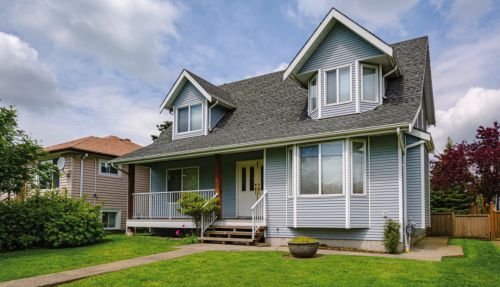All
Redefining Zero

NEFI Responds to EERE Definition of Zero Emissions Building
On January 9, 2024, the U.S. Department of Energy (DOE) published a request for information (RFI) seeking public input on the creation of a new national standard for a “zero-emissions building.” This initiative aligns with the Biden Administration’s broader electrification goals. The National Energy & Fuels Institute (NEFI) submitted a response to the RFI, raising several concerns with the agency’s proposed approach.
A primary concern is the agency’s focus on a narrow “zero-emissions” standard, rather than a more flexible “net-zero” emissions approach. As NEFI noted in its response, “A ‘net-zero’ emissions approach would allow the inclusion of renewable liquid heating fuels that can dramatically reduce emissions compared to traditional sources, and without the need to convert the entire building to costly electric heating systems.”
The proposed zero-emissions standard, as it stands, risks sidelining these viable, cost-effective alternatives in favor of electrification. NEFI warns that such a shift could not only impose significant costs on consumers and small businesses but also restrict consumer choice and access to a diverse energy market. NEFI stressed the importance of recognizing the role of energy-efficient heating systems and appliances, as well as low-carbon and net-negative emissions biofuels, in achieving stated environmental targets.
In developing this standard, NEFI urged the DOE to account for full lifecycle greenhouse gas emissions, including upstream emissions from electricity generation, rather than just on-site emissions. The response cautioned that an overly narrow approach focused solely on electrification could jeopardize grid reliability and security and pose a significant financial burden on working families and small businesses.
“The proposal misses an opportunity to more aggressively reduce carbon emissions by focusing only on a ‘zero emissions’ building standard,” NEFI stated in its response. The group advocated for the inclusion of renewable liquid heating fuels like biodiesel-blended heating oil and renewable diesel, which can dramatically reduce net emissions while maintaining energy resilience.
A national zero-emissions building standard could have major implications for the heating fuel industry, potentially restricting the use of traditional heating fuels in buildings. While non-binding, such a standard could influence state and local policies, building codes, and consumer choices.
The DOE indicates that additional RFIs are forthcoming, covering issues like grid reliability, refrigerant emissions, and embodied carbon. NEFI plans to monitor these developments closely and continue advocating for a flexible, technology-neutral approach to reducing building sector emissions.
The DOE Request for Information was formatted as a list of questions. Oil & Energy is providing its readers with the NEFI’s full response. Questions 1 through 4 were related to organization and contact information.
5. Are the draft criteria clear and appropriate for the definition of a zero emissions building? Should any other criteria be considered for Part 1? Please provide specific feedback about this draft definition.
The draft criteria are not fully appropriate for defining a true zero emissions building. While including “highly energy efficient” buildings is appropriate, confining the criteria only to “on-site emissions from energy use” rather than full lifecycle source emissions is misguided. Reducing whole lifecycle emissions requires considering the upstream emissions from generation of the energy used in the building, including emissions from off-site electricity production.
For the criteria requiring the building to be “powered solely from clean energy” sources, the definition must account for full lifecycle emissions of those sources, not just direct on-site emissions. Many renewable liquid heating solutions like biodiesel-blended heating oil (commonly referred-to as Bioheat Fuel) or renewable diesel can reduce net emissions when utilized on-site but appear to be excluded under the current narrow criteria, which is focused solely on direct emissions, and the definition of “clean energy.”
Furthermore, the proposal misses an opportunity to more aggressively reduce carbon emissions by focusing only on a zero emissions building standard rather than a net-zero emissions standard. A net-zero emissions approach would allow the inclusion of renewable liquid heating fuels that can dramatically reduce emissions compared to traditional sources, and without the need to convert the entire building to costly electric heating systems. Next-generation cellulosic heating fuels like ethyl levulinate (EL) can play a key role in a net-zero emissions building standard. EL is a *net negative* emissions fuel derived from forestry/agricultural residues, municipal solid waste, and other sources that is being developed for the heating oil market. EL has cold weather performance properties that exceed all other fuels, making it an exceptional solution for building emissions reductions in cold climates.
Lastly, we strongly encourage the EERE to consider the vital role of hybrid heating systems, which combine electric heat pumps with liquid- or gas-fired furnaces/boilers and generators to ensure consistent warmth and backup power, especially in colder climates. Excluding hybrid systems overlooks a key pathway to decarbonization while maintaining energy resilience and the health and safety of building occupants year-round.
6. Should energy efficiency be considered a criteria for the definition of a zero emissions building? If the efficiency of an existing building should be considered, do you agree that requiring energy performance in the top 25% of similar buildings is an appropriate measure of energy efficiency for this definition? (ENERGY STAR® score of 75 or above.) Should it be higher or lower? Are there other benchmarks or approaches that should be considered? For an existing building, is one year of measured energy performance an appropriate requirement for demonstrating efficiency or is another approach appropriate?
We choose not to answer the question about energy efficiency criteria for the definition at this time but reserve the right to provide additional guidance in a future RFI or proposed rulemaking.
7. For existing buildings, are the draft criteria appropriate for single-family homes? Are there other benchmarks that should be considered for single-family homes?
We choose not to answer the question about draft criteria for existing single-family homes at this time but reserve the right to provide guidance later.
8. For new construction, are the draft criteria appropriate?
The modeled building performance is at least 10% lower than the energy use according to the latest version of IECC or ASHRAE 90.1 (e.g. model energy code) and the building is designed to achieve an ENERGY STAR design score of at least 90 (for eligible buildings). Are there other benchmarks that should be considered?
We choose not to answer the question about draft criteria for new construction at this time but reserve the right to provide guidance later.
9. For new construction, are the draft criteria appropriate for single family homes? Are there other benchmarks that should be considered for single family homes?
We choose not to answer the question about draft criteria for new single-family home construction at this time but reserve the right to provide guidance later.
10. Should there be an exemption allowed for emission producing emergency generation? Are there any other exemptions needed?
There should absolutely be an exemption allowed for emission-producing emergency generators, which are critical life safety backups during power outages, especially in cold climates where health resilience is paramount. There must also be an exemption for hybrid systems which may be vital to the health and safety of homeowners, particularly in colder climates.
11. Should biofuels consumed on-site be allowed? If so, how?
Renewable liquid biofuels like biodiesel blended heating oil (commonly referred to as Bioheat Fuel) or renewable diesel should be permitted for on-site use to reduce net emissions while maintaining energy resilience. The definition should account for lifecycle emissions reductions from these fuels, and again, adopt a net-zero rather than “zero sum” approach.
12. Are the clean energy criteria provided appropriate for this definition? Are there other clean energy criteria that should be considered? Should community solar qualify for the requirement? If so, how?
The “clean energy” criteria should focus on full lifecycle emissions reductions and avoid being overly narrow, and renewable liquid heating fuels should qualify under the criteria.
13. Should there be a proximity requirement for off-site power used to meet the clean power criterion? If so, how should a proximity requirement be implemented (e.g., regional definition, phase-in, etc.)?
We choose not to comment on whether there should be a proximity requirement for off-site clean power at this time. However, we urge the EERE to fully evaluate regional and local variations in energy production, use, and demand; and climatic, environmental, and economic considerations.
14. Should organizations leveraging the definition be able to determine whether buildings have to meet it annually, one time, or on a different frequency?
Organizations leveraging the definition should be required to meet it annually or over some other period to properly account for seasonality in building energy usage, especially heating needs in cold climates. Greenhouse gas calculations should be performed on an annualized basis over a full heating/cooling cycle.
15. If the definition is extended to single family homes, what documentation should be required?
We choose not to comment on documentation requirements if extending the definition to single-family homes at this time.
16. Are licensed professional and third-party certification bodies the appropriate parties to independently verify the documentation that a building has met the definition? Beyond existing government resources such as EPA’s ENERGY STAR Portfolio Manager, are there other methods to verify meeting the zero emissions building definition?
Licensed professionals and third-party certifiers are certainly appropriate verification entities, but the program should be flexible in the approved methods for verification across all building types, and allow pathways for industry and professional groups to suggest additional proposals.
Verification criteria must ensure aligning incentives/programs, making processes standardized yet flexible, ensuring quality assurance, maintaining affordability, and promoting workforce education.
17. What time frame should be used for GHG calculations (i.e. hourly, monthly by year, annually)? Explain how this would be implemented effectively across the market.
To properly account for seasonality in building energy usage, especially heating in cold climates, greenhouse gas calculations should be performed on an annualized basis over a full heating/cooling cycle.
18. What other verification criteria are necessary to make this definition useful for the marketplace?
Additional verification criteria necessary to make the definition useful include ensuring flexibility across building types, allowing industry input on verification methods, aligning incentives and programs, standardizing but allowing flexibility in processes, ensuring quality assurance, maintaining affordability, and promoting workforce training.
19. Are there any issues regarding conflict or synergy with regional, state or local energy and climate programs that ought to be addressed?
In developing a new zero-emissions standard, the EERE must consider regional, state, or local energy and climate programs. Many states, particularly those in the Northeast, are adopting aggressive decarbonization targets and policies, and in many cases have adopted – or are actively considering - renewable fuel blending requirements and incentives in order to help achieve these ambitious goals. For instance, New York, Connecticut, and Rhode Island all now require biofuel blending in their states’ heating oil supply, which are expected to increase to as much as 50-percent or more in the coming years. Several states are considering “clean heat standards” which will offer emissions reduction credits to businesses that sell or utilize renewable liquid heating fuels. These varied state and regional actions form a patchwork of regulations that will shape the policy for years to come; and they may yet change further as concerns grow over whether building electrification targets are achievable given the high associated costs and related equity concerns, implications for grid reliability and security, and other considerations. These factors must be carefully considered and integrated into federal standards to ensure synergy and avoid conflict.
20. Is it important for a national definition to cover all building types, including commercial, multifamily, and single-family?
If the EERE proceeds with drafting a definition that encompasses all building types, it’s essential to evaluate the varied needs and preferences across commercial, multifamily, and single-family homes. Not all buildings, nor their occupants’ budgetary requirements and preferences, are alike. “Sealing up” a home an older existing home could also significantly affect indoor air quality of the home due to much lower air-changes per hour. Collaboration with the EPA, health organizations, and stakeholders is recommended. Additionally, achieving high efficiency in existing homes, predominantly inhabited by lower- and middle-income families, may prove costly, especially if reliant solely on electric solutions, potentially compromising the administration’s energy equity and affordability goals. This approach underscores the complexity and need for flexibility in developing standards across different building types.
21. Are there any other recommendations that would help clarify and improve the definition?
Key recommendations to improve the definition include: Changing the program from a “zero emissions” building standard to a “net-zero emission” building standard and enable more emissions reduction pathways; Accounting for full lifecycle emissions, not just on-site, and the inclusion of renewable liquid heating fuels in the definition of “clean energy” sources; accounting for hybrid heating systems with liquid/gas backups which are needed for resilience and consumer safety; and addressing equity and affordability concerns, especially for owners or residents of existing housing stock, which are often lower-income households that are unable to afford costly conversions to all-electric appliances and heating systems to achieve a “zero emissions” standard.
22. While Part 1 of the definition focuses on operating emissions, what other areas should be considered in future parts of the definition, such as embodied carbon, refrigerant, and grid interactivity?
An exclusive focus on electrification as the sole pathway for building decarbonization can jeopardize grid reliability and resilience, particularly during peak demand in extreme cold when renewable generation may be limited. Renewable liquid heating fuels (RLHFs) offer a cost-effective and efficient means for storing substantial energy, with a standard 250-gallon home fuel tank equivalent to 10 megawatts of stored energy. The elimination of this decentralized storage, in favor of an electrified-only approach, risks increased reliance on less stable fuel sources and the potential for grid instability, as well as greater peaking emissions. Furthermore, this shift could lead to more frequent and prolonged blackouts or brownouts, posing serious health risks in colder climates and potentially eroding public support for emission reduction initiatives. It is crucial that the EERE acknowledge the importance of RLHFs to maintain energy resilience and public safety without compromising emissions reduction goals of this program or the broader net-zero goals of the administration.
23. Other questions or comments not included above.
None at this time.
Related Posts
 From Retailer to Representative: Chris Keyser’s Road to the Vermont State House
From Retailer to Representative: Chris Keyser’s Road to the Vermont State House
Posted on June 16, 2025
 Northeast Working Group for Industry Principles Gets to Work
Northeast Working Group for Industry Principles Gets to Work
Posted on May 8, 2025
 Trump Policies and Energy Markets
Trump Policies and Energy Markets
Posted on April 28, 2025
 NEFI Introduces the National Home Comfort PAC
NEFI Introduces the National Home Comfort PAC
Posted on April 28, 2025
Enter your email to receive important news and article updates.
